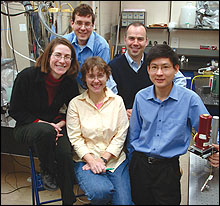Archives
Junior physics faculty lead the way
Five members of department are current recipients of NSF CAREER Awards
By LAUREN MAYNARD
Reporter Contributor
Attention to excellence in hiring and teaching has led to an impressive number of nationally recognized new faculty awards in the Department of Physics. The department, which has marked consistent growth in the past few years, boasts a remarkable five current National Science Foundation (NSF) awards, three of which are new for 2006.

Five faculty members in the
Department of Physics are current recipients of prestigious National
Science Foundation Faculty Early Career Development Awards, commonly
known as CAREER Awards. They are, clockwise from rear, John Cerne, Igor
Zutic, Hao Zeng, Doreen Wackeroth and Andrea Markelz.
PHOTO:
NANCY J. PARISI
"Compare that to the numbers I saw online recently for Ohio State, a significantly larger school than UB—something like four CAREER awards for the entire university—and we have a lot to be proud of," says Frank Gasparini, professor and chair of the physics department in the College of Arts and Sciences.
The Faculty Early Career Development Award, or CAREER award, is the NSF's prestigious recognition of new faculty achievement in both teaching and research. Five-year grants ranging up to $600,000, CAREER awards encourage principal investigators to combine their research projects with an educational element; proposals must tie research to pedagogical applications in the natural sciences. Overall, UB faculty members hold 14 NSF CAREER awards in such fields as engineering, biology, chemistry and geography, as well as physics.
Doreen Wackeroth, Igor Zutic and Hao Zeng, all assistant professors, are the latest recipients from the physics department. All three will begin their projects this year, and join colleagues John Cerne and Andrea Markelz, who are in the mid-award stage of their CAREER funding.
A quantum physicist, Wackeroth is working to find alternative models of the Standard Model—the commonly held theory of how matter behaves in the universe. While her CAREER award officially will begin in July, she already is at work on her project, hiring a postdoctoral student to help with complex calculations and planning an interdisciplinary, educational art exhibit for the spring.
Zutic is working with another theoretical area of physics, spin transport and spintronic devices, which may lead to new advances in electronics using nanotechnology. His research is supported by the CAREER award, as well as a three-year grant from the U.S. Office of Naval Research.
Zeng's CAREER funding, which began in February, will fund his condensed matter research of nanoscale materials and devices. He plans to combine nanotechnology and nanoscience into a curriculum for students as part of the NSF project.
Cerne and Markelz, who are married, are both assistant professors of physics whose research has been nationally recognized. Cerne's 2005 CAREER grant is funding his study of "strange metals" used in high-temperature superconductors and magnetic semiconductors. Markelz, who received her award in 2004, is developing revolutionary new equipment to determine how protein flexibility affects protein function.
Gasparini points out there are two key reasons for the concentration of NSF accolades within the physics department: The CAS has made the hiring of talented new faculty a priority with the college, and the physics department has created a teaching culture within the department. Whenever possible, senior faculty members help support and educate their junior colleagues in becoming better instructors through team-teaching and mentorships. It's a trickle-down theory that has worked, Gasparini says, attracting talented scientists from around the world and making physics a desirable field for graduate students and undergraduate majors as well. A number of spousal hires also has helped attract and retain talent, he adds.
"I see everyone taking great pride in their teaching," says Uday P. Sukhatme, dean of CAS and a member of the physics faculty who recently team-taught Physics 101 with Wackeroth. "A teaching culture is also important for a department like physics. It is thought of as a difficult subject, so you find that teaching is often emphasized to make people feel more comfortable."
Sukhatme notes that the CAS faculty has grown 20 percent in just three years. The Department of Physics has added 13 new faculty members since 2000.
While student enrollment in physics has started to creep up nationally, UB's numbers are even higher. "We've gone beyond the national average, and now it's become a recruitment tool to bring in new people," Gasparini says.
UB has bounced back from a low of 17 physics faculty members in the mid-1990s to 27 full-time faculty members last year. Gasparini says he would like to see that number increase to 35.
"We are still a relatively small department, but we hope that increasing faculty numbers will allow us to offer them better course loads." Specialty courses, Web-based grading and other improvements have been embraced by new faculty and students alike, he says.
Junior faculty members in the physics department also have the opportunity to sit on search committees and serve as chair. "Our department is now 50 percent new faculty, and naturally they have a very important role in determining where the department is headed," says Gasparini.
"This is just the beginning. I'm looking ahead to when I retire and seeing a department with lots of exciting things going on."
